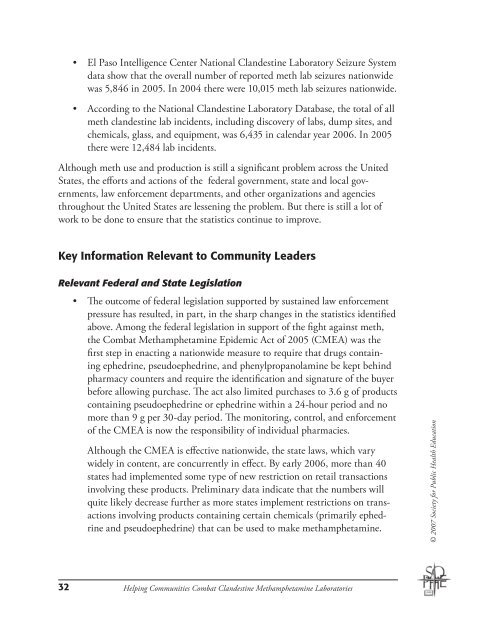Part A - Society for Public Health Education
Part A - Society for Public Health Education
Part A - Society for Public Health Education
- No tags were found...
You also want an ePaper? Increase the reach of your titles
YUMPU automatically turns print PDFs into web optimized ePapers that Google loves.
• El Paso Intelligence Center National Clandestine Laboratory Seizure Systemdata show that the overall number of reported meth lab seizures nationwidewas 5,846 in 2005. In 2004 there were 10,015 meth lab seizures nationwide.• According to the National Clandestine Laboratory Database, the total of allmeth clandestine lab incidents, including discovery of labs, dump sites, andchemicals, glass, and equipment, was 6,435 in calendar year 2006. In 2005there were 12,484 lab incidents.Although meth use and production is still a significant problem across the UnitedStates, the ef<strong>for</strong>ts and actions of the federal government, state and local governments,law en<strong>for</strong>cement departments, and other organizations and agenciesthroughout the United States are lessening the problem. But there is still a lot ofwork to be done to ensure that the statistics continue to improve.Key In<strong>for</strong>mation Relevant to Community LeadersRelevant Federal and State Legislation• The outcome of federal legislation supported by sustained law en<strong>for</strong>cementpressure has resulted, in part, in the sharp changes in the statistics identifiedabove. Among the federal legislation in support of the fight against meth,the Combat Methamphetamine Epidemic Act of 2005 (CMEA) was thefirst step in enacting a nationwide measure to require that drugs containingephedrine, pseudoephedrine, and phenylpropanolamine be kept behindpharmacy counters and require the identification and signature of the buyerbe<strong>for</strong>e allowing purchase. The act also limited purchases to 3.6 g of productscontaining pseudoephedrine or ephedrine within a 24-hour period and nomore than 9 g per 30-day period. The monitoring, control, and en<strong>for</strong>cementof the CMEA is now the responsibility of individual pharmacies.Although the CMEA is effective nationwide, the state laws, which varywidely in content, are concurrently in effect. By early 2006, more than 40states had implemented some type of new restriction on retail transactionsinvolving these products. Preliminary data indicate that the numbers willquite likely decrease further as more states implement restrictions on transactionsinvolving products containing certain chemicals (primarily ephedrineand pseudoephedrine) that can be used to make methamphetamine.© 2007 <strong>Society</strong> <strong>for</strong> <strong>Public</strong> <strong>Health</strong> <strong>Education</strong>32 Helping Communities Combat Clandestine Methamphetamine Laboratories
















